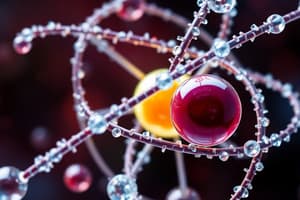Podcast
Questions and Answers
What is the significance of the atomic number (Z) in an atom?
What is the significance of the atomic number (Z) in an atom?
- It corresponds to the total number of nucleons in an atom.
- It represents the number of neutrons in the nucleus.
- It indicates the number of protons present in the nucleus. (correct)
- It equals the total mass of the atom in atomic mass units.
Which statement accurately describes isotopes?
Which statement accurately describes isotopes?
- They are the same element with different energy states.
- They have the same mass number but different atomic numbers.
- They have the same atomic number but different mass numbers. (correct)
- They are atoms of different elements with the same number of neutrons.
What characterizes a stable nucleus?
What characterizes a stable nucleus?
- It has a mass number equal to the atomic number.
- It has an equal number of protons and neutrons. (correct)
- It is always larger than an unstable nucleus.
- It contains no excess energy.
Which of the following best describes unstable nuclei?
Which of the following best describes unstable nuclei?
What is the relationship between the mass number (A) and the number of neutrons in an atom?
What is the relationship between the mass number (A) and the number of neutrons in an atom?
What happens to the nucleus after the emission of radiation if it remains in an excited state?
What happens to the nucleus after the emission of radiation if it remains in an excited state?
Which of the following statements is true about alpha decay?
Which of the following statements is true about alpha decay?
During beta-minus decay, what occurs within the nucleus?
During beta-minus decay, what occurs within the nucleus?
What is the result of a positron emission during beta-plus decay?
What is the result of a positron emission during beta-plus decay?
What is true regarding gamma decay?
What is true regarding gamma decay?
Flashcards are hidden until you start studying
Study Notes
Atomic Structure
- Matter is composed of atoms.
- An atom has a positively charged nucleus consisting of protons and neutrons, along with negatively charged electrons revolving in orbital shells.
- Protons carry a positive charge (p+), electrons carry a negative charge (e-), and neutrons carry no charge (n±).
- An electron's mass is approximately 1/2000th the mass of a hydrogen atom.
- The masses of a proton and a neutron are considered to be 1 unit, equivalent to the mass of a hydrogen atom.
Nucleus Designation
- A nucleus is represented as ZXA where Z is the atomic number and A is the mass number.
- Atomic number (Z): Represents the number of protons in the nucleus.
- Mass number (A): Represents the sum of protons and neutrons in the nucleus.
Isotopes, Isobars, Isotones, Metastable State
- Isotopes: Atoms of the same element with the same atomic number but different mass numbers (different number of neutrons).
- Isobars: Atoms of different elements with different atomic numbers but the same mass number.
- Isotones: Atoms of different elements with different atomic numbers and mass numbers but the same number of neutrons.
- Metastable state: Atoms of the same element with the same atomic and mass numbers but different energy states.
Stable and Unstable Nuclei
- There are approximately 1500 known nuclides.
- Stable nuclei: About 300 nuclides remain stable, with a 1:1 ratio of protons (P) to neutrons (N).
- Unstable nuclei (radioactive): Approximately 1200 nuclides are unstable, with an imbalance in the number of protons and neutrons, leading to either a neutron excess or deficit.
- 65 natural radioactive nuclides occur naturally, with the rest being human-made.
Radioactive Decay
- Radioactive nuclei possess excess energy and strive to achieve a lower energy state.
- This energy release often involves the emission of particles (α, β, γ) from the nucleus, changing the nucleus from one form to another.
- Nuclear transformation can be represented as: XA → YA + W + Q, where
- X is the parent nucleus,
- Y is the daughter nucleus,
- W is the emitted radiation particle,
- Q is the energy released, derived from the mass difference between the parent nucleus and the combined mass of the daughter nucleus and emitted particle.
Modes of Radioactive Decay
Alpha Decay (α Decay)
- Occurs in heavy nuclei with high atomic numbers (Z).
- Coulomb repulsion between protons overcomes the nuclear force binding the nucleons together.
- Alpha particles (α) are positively charged and deflected by electromagnetic fields. They are stopped by a few sheets of paper or a few centimeters of air.
Beta Decay (β Decay)
-
A) Nuclides with neutron excess (β- decay):
- The nucleus has an excess of neutrons.
- A neutron transforms into a proton and an electron, ejecting the electron (negative β particle) from the nucleus.
- The negative β particle (e-) has the same mass and charge as an electron and can be deflected by electromagnetic fields.
- It is stopped by a few sheets of aluminum.
- An antineutrino (v) is also emitted, carrying no charge and having negligible mass, hence rarely interacts.
-
B) Nuclides with neutron deficit (β+ decay):
- The nucleus has a deficiency of neutrons.
- A proton transforms into a neutron and a positron (positive β particle), which is ejected from the nucleus with high energy.
- The positron encounters a nearby electron, resulting in their annihilation.
- Their combined masses are transformed into energy, producing two photons of annihilation radiation.
-
C) K Electron Capture (EC):
- Occurs in nuclei with a neutron deficit as an alternative to β+ decay.
- The nucleus captures an electron from the K-shell to increase its neutron-to-proton ratio.
- The daughter nuclide emits characteristic X-rays when the hole in the K-shell is filled by another electron from an outer shell.
Gamma Decay (γ Decay)
- Gamma rays (γ) have the same characteristics as X-rays, but they originate from within the nucleus.
- They are emitted either instantaneously with the emission of beta or alpha particles or with a delay after beta or alpha emission.
Isomeric Transition (IT)
- Occurs when gamma rays are not emitted immediately but are delayed after the emission of a beta particle.
- Involves an excited state of the daughter nucleus.
- IT is a pure gamma decay process.
Internal Conversion (IC)
- The energy released during isomeric transition can be transferred to an electron ejected from the atom (internal conversion electron).
- Electron rearrangement follows, filling the created vacancy, resulting in the emission of characteristic X-rays and/or Auger electrons.
Decay Series
- Emission of particles or gamma rays can occur in a series to bring the nucleus to a stable or ground state, as the emission of a single particle often leaves the nucleus in an excited state.
- Example: 54Xe139 → 55Cs139 → 56Ba139 → 57La139, with a chain of beta decays leading to a stable daughter nucleus.
Exponential Law of Decay
- Radioactive decay is a random process, meaning it's impossible to predict when a specific atom will decay.
- The amount of radioactive material remaining after time t can be calculated using the exponential decay law: N = N0e-λt, where
- N is the number of radioactive atoms at time t,
- N0 is the number of radioactive atoms at the initial time (t0),
- λ is the decay constant, which is inversely proportional to the half-life time.
Physical Half-Life (T1/2)
- Time required for a given number of radioactive nuclei to decay to half of their original value.
- For isotopes stored in a bottle, decay occurs with their respective physical half-lives.
- The decay constant (λ) is inversely proportional to the half-life (T1/2).
Biological Half-Life
- Time required for a body to eliminate half of a substance through metabolic turnover and excretion.
Effective Half-Life
- Time for the radioactivity of a substance deposited in tissues to decrease to 50% due to combined effects of radioactive decay and biological elimination.
- Effective half-life is shorter than physical or biological half-lives due to the combined action of radioactive decay and metabolic turnover.
- Equation: 1/ effective t1/2 = 1/ biological t1/2 + 1/physical t1/2.
Units of Radioactivity
- Curie (Ci): Older unit, representing the radioactivity of a sample that decays at a rate of 3.7 x 10^10 disintegrations per second. Equivalent to the activity of one gram of radium-226.
- Becquerel (Bq): SI unit of radioactivity, defined as one disintegration per second.
- 1 Ci = 37 GBq
Decay Equilibrium
- A condition achieved when both parent and daughter isotopes in a mixture are radioactive and the daughter's half-life is shorter than the parent's.
Secular Equilibrium
- Occurs when the daughter's half-life is significantly shorter than the parent's half-life (parent T1/2 >> daughter T1/2).
- Achieved after six half-lives of the daughter.
- Decay rate of the parent (and production rate of the daughter) is roughly equal, as the parent's half-life is much longer.
- The daughter appears to decay with the parent's half-life.
Transient Equilibrium:
- Achieved when the daughter's half-life is shorter than the parent's half-life (parent T1/2 > daughter T1/2).
- Occurs after four half-lives of the daughter.
- Example: 99Mo decay (67 hours) to 99mTc decay (6 hours).
Studying That Suits You
Use AI to generate personalized quizzes and flashcards to suit your learning preferences.




